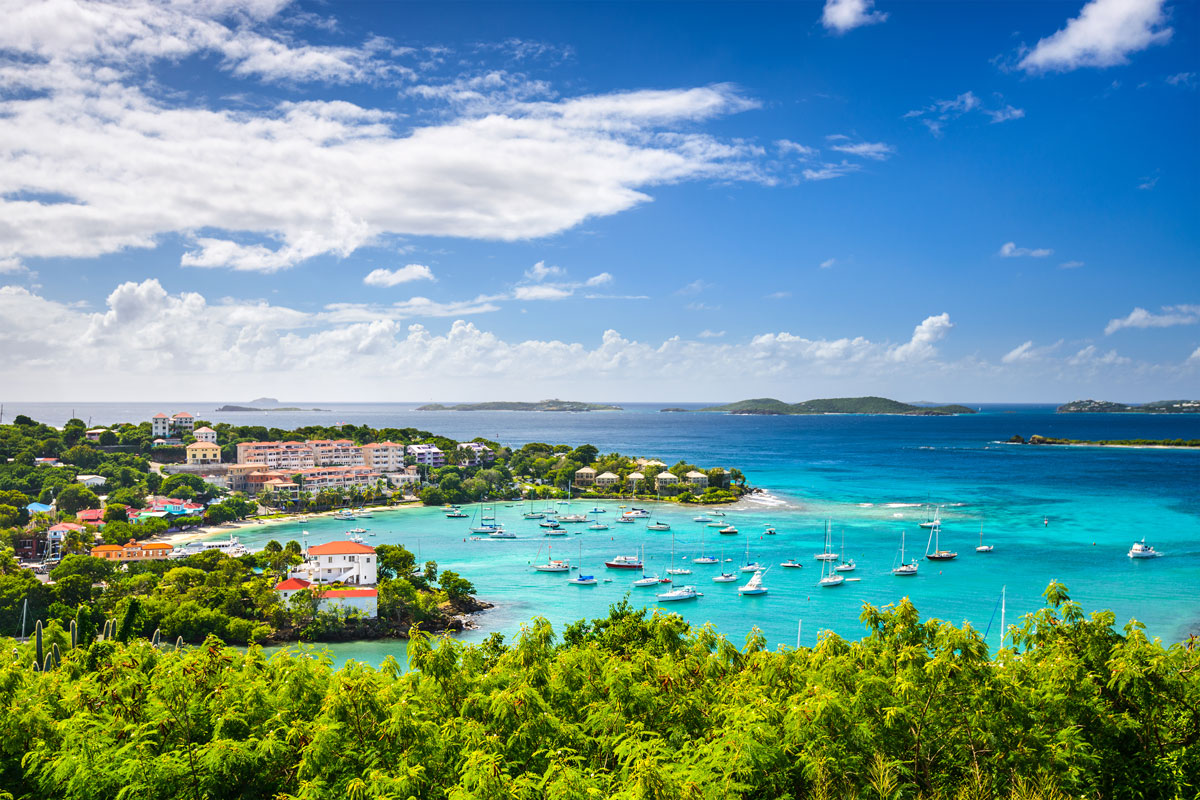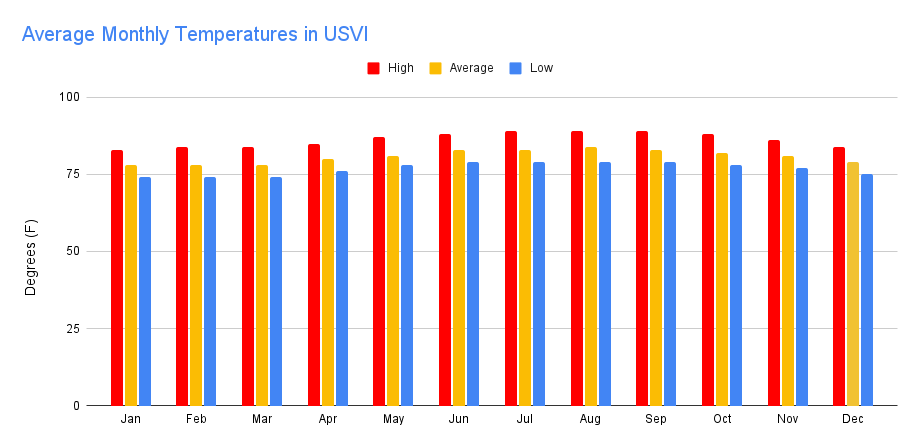Marketplace Suites Blog
When Is The Best Time To Visit US Virgin Islands?

If you are thinking of traveling to the US Virgin Islands, you’ll be happy to know that this Caribbean gem has perpetual summer weather all year-round. In a nutshell, that means that their magnificent beaches, with their crystal clear waters, stay pleasant and inviting throughout most of the year. Whether you're a remote worker looking for a long term stay or a tourist looking for a relaxing vacation, we’ve put together a guide of the ideal times to visit the USVI to help you plan your dream vacation.
When is the Best Time to Visit the US Virgin Islands?
The best time of the year to visit the US Virgin Islands is mid-April through June as the dry season ends, hotel and resort/villa rates drop, and the average temperatures are mild. Additionally, peak tourism season has ended and the region's hurricane season hasn't started. For the most part, the weather in the US Virgin Islands is sublime.
When is the Best Time to Visit St. Thomas, St. John and St. Croix?
January through May are the best times to visit. St. Thomas' Carnival Festival is held in April or May. Tourism drops off, making flights and hotels cheaper than in the prior periods. Best time of year to visit with the combination of cheaper prices, fewer people, and mild temperatures. To be more specific, the best time to visit St. John, St. Thomas and St. Croix is from January 22nd to April 15th, as that is when you can expect the mildest weather. As the calendar moves into summer and fall, there are still many beautiful days, but an increased risk of stormy weather. For St. John, Mid-December to April is considered to be the best season on St. John Island, and it is the most popular time to visit. It is sometimes known as tourist season because it is the busiest time that tourists visit the area.
Weather in the US Virgin Islands
The Virgin Islands ranks in the 37th percentile for lovely weather when compared to other tourist destinations around the globe. You can expect daytime temperatures to range on average from 84°F in winter to 89°F in the summer. Average temperatures at night range from 70°F to 76°F at night, respectively. Read more about the USVI vs. other Caribbean islands here.
The Trade Winds Govern the Weather
One of the defining characteristics of the weather in the Virgin Islands is the trade winds, and they gust to about five to 10 knots around the end of July. During winter, you can expect them to increase to around 10 to 20 + knots, with gusts reaching well over 30 knots in some circumstances. The website windy.com is really good to use when planning activities such as boating around the trade winds.
About the Hot Weather and Humidity
The old expression goes, “It’s not the heat; it’s the humidity.” And, that saying is especially true in the US Virgin Islands, where the humidity can make it feel much hotter. If you want to avoid going during the island’s sultriest periods, then plan your vacation outside of July through September. July is the most humid month in the USVI with 76.2% RH, and February is the least muggy, with the monthly average coming in at 66.1% RH.
Is There a Rainy Season in the USVI?
Rainfall Can Vary
There is a very low chance of rain throughout most of the year in the Virgin Islands, but the rainfall can vary from month-to-month. If you want to avoid heavy downpours, though, avoid going to the region in August, September, October and November. The lowest chance of precipitation in the USVI is January, February, and then March.
Snapshot of USVI Weather by Month
So, just when is the best time to visit the US Virgin Islands? If you are still unsure of when to take your trip, here is an overview of USVI weather by month.

[source: weatherspark.com]
USVI Weather in January
January in the USVI is very busy, and it is one of the coldest months of the year, which only means it’s still going to stay in the mid-80s during the day. The month is also part of the dry season.
February
February, like January, sees average highs in the mid-80s. The month is also peak tourism season, so expect to pay higher rates for airfare and lodgings.
March
The dry season continues in March, and average highs are around 85-86°F. March also marks the last month that tourism is in full swing.
April
April is one of the best months to take a vacation in the US Virgin Islands, and the pretty weather is very similar to what you'd experience in March on the mainland. Highs are around 86-87°F
May
Busy tourism is a forgotten memory in May, and the average temperatures stay around 87-88°F. In other words, it’s prime time to head to St. John, St. Thomas or St. Croix for good times and some sun without rubbing elbows with everyone.
June
June is as great a time to visit the US Virgin Islands as it is in April and May. At this time, the beaches are still not overcrowded. It is also the start of the wet season, but, fortunately, the tropical showers that pop up from late spring and last to mid-summer don’t last very long. Highs in June are around 88-89°F
July
This month sees an increase in rain showers, although peak hurricane season is yet to arrive. Highs in the daytime are around 89-90°F.
August
The average temperatures are the highest in August (90°F), and it’s also, coincidentally, the sunniest month of the year. Make sure you bring your water bottle with you! If you do book a stay at a villa or hotel, you will usually enjoy lower rates during this time.
September
Ocean temperatures warm up to the mid-80s in September, making it the best time of the year for swimming. The month also marks the beginning of peak hurricane season, so concerned vacationers should purchase travel insurance if they are heading here for a stay.
October
Peak hurricane season continues into this month. October is also the wettest month of them all, with the region experiencing a little over 6 inches of the wet stuff on average. Guests to the USVI should expect to pack their rain gear.
November
November ushers in cooler temperatures, but it also ushers out hurricane season. Average highs are going to be about 87°F. November is also the last month before tourism picks up again, so cost-savvy travelers should book their stay in the US Virgin Islands during this time.
December
December is the beginning of peak tourist season, and the dry season officially begins in the USVI. And, as they do in November, temperatures sizzle. You can expect more crowded beaches and waitlists when you go to restaurants at this time, too, so be prepared.
Where To Stay
If you are thinking of booking a vacation in the beautiful US Virgin Islands, why not stay with us at Market Place Suites at Cruz Bay, St. John? When you stay in one of our Premier Suites, you can enjoy many resort-like amenities without paying the typical high resort fees. For more information about fun things to do and what to expect in the US Virgin Islands, you can call us at 1-800 727-6610 to discuss. Alternatively, you can contact us online, and one of our friendly staff members will quickly get back with you.







